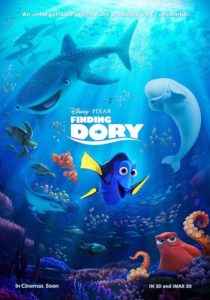
Rating: 4/5
Three Word Summary: Dory remembers family
If Pixar has taught us anything, it’s that they know how to handle sequels.
Toy Stories 2 & 3, and Monsters University lived up to their outstanding originals; with a highly anticipated Toy Story 4 and Incredible follow-up scheduled. (I won’t comment on Cars 2 since I didn’t see it and don’t plan to).
I will say for all Pixar sequels that you typically need to have seen the first installment to get the full effect of all the jokes and delicate character development. However, seeing one alone is still enough for the basic plot to make sense.
Finding Dory was no exception to this rule. It did just enough to pay homage to Finding Nemo, while also standing up as its own unique film.
It plays on Dory’s short-term memory loss, established in Finding Nemo. However, what was a funny (if slightly frustrating) characteristic in the first film, becomes a sadly debilitating flaw in the second.
The filmmakers use Dory’s fragmented memories to slowly piece together her past as she slowly recalls a family that she lost and almost forgot. With the help of Marlin and Nemo, she crosses the ocean to find them.
Thankfully, Pixar shifted the scene from the open ocean to a ocean rescue facility in California. This was done to differentiate the two films. There, Dory meets a cranky octopus, near-sighted whale shark, bumbling beluga whale and several other sea creatures who help her on her quest.
While Finding Dory didn’t quite have the same freshness as Finding Nemo did when it was released over 12 years ago, Dory is able to draw on many of the same emotions of loss, family and home. And its able to do so in different enough ways that it doesn’t feel overwrought or forced.
All in all, Finding Dory is by no means Pixar’s best achievement, but it is further proof that they are able to maintain quality in creating film series, where most studios usually diminish.